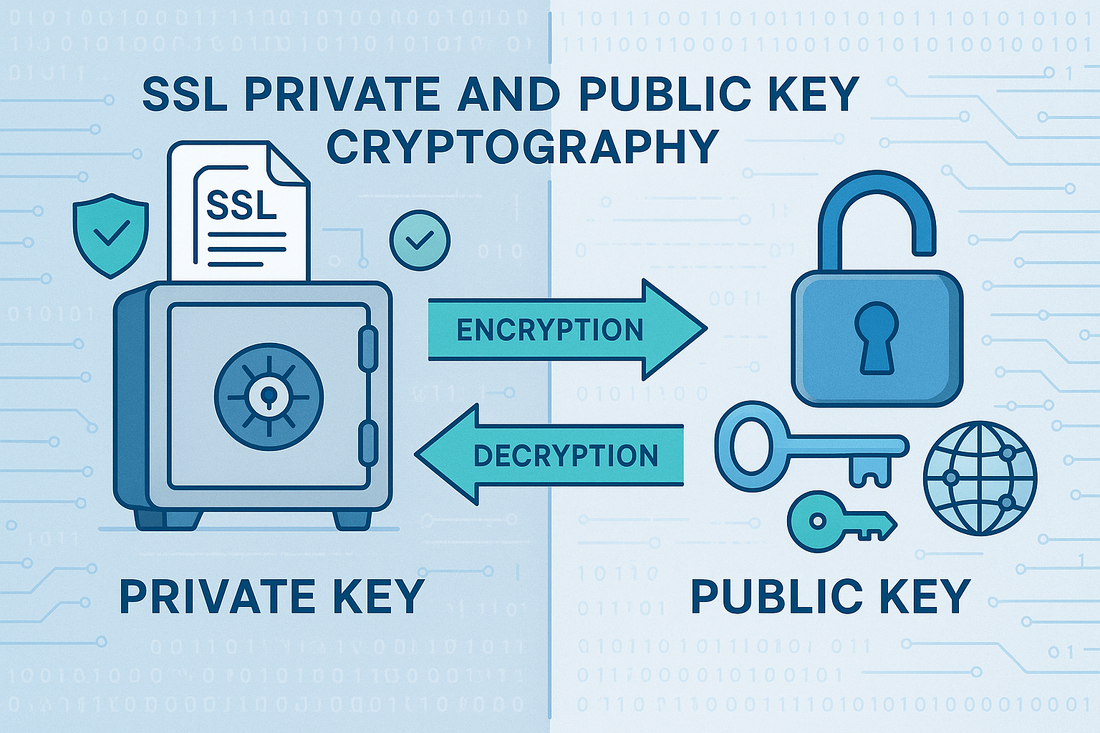
SSL Certificate Private Key and Public Key
Andrew JohnsonShare
Private Keys and Public Keys form the cryptographic foundation of SSL Certificate technology, providing the security framework that protects online transactions.
Understanding these concepts is essential for anyone implementing SSL Certificates on their websites or applications. This encryption system ensures data remains secure during transmission between servers and browsers.
What is a Private Key
A Private Key represents the secret component of your SSL Certificate's cryptographic key pair.
This mathematical key must remain confidential and secure on your web server at all times. When you generate a Certificate Signing Request (CSR) for your SSL Certificate, the Private Key is created simultaneously and stored securely on your server.
The Private Key serves multiple critical functions in SSL Certificate operations.
It decrypts incoming encrypted data and creates digital signatures that verify your server's identity. The security of your entire SSL Certificate implementation depends on protecting this Private Key.
Trustico® SSL Certificates work with Private Keys generated using industry-standard algorithms including RSA, DSA, and Elliptic Curve Cryptography (ECC).
The strength of your Private Key directly correlates to the bit length used during generation. Currently, we recommend minimum 2048-bit RSA keys for all SSL Certificate implementations, though stronger 4096-bit keys and modern ECC alternatives are also supported for enhanced security.
Private Key management represents a critical aspect of SSL Certificate deployment.
The Private Key never leaves your server and should be backed up securely. If your Private Key becomes compromised, you must immediately revoke your SSL Certificate and generate a new key pair.
Understanding Public Keys
The Public Key represents the openly shared component of your SSL Certificate's cryptographic system.
Unlike the Private Key, the Public Key can be freely distributed and is actually embedded within your SSL Certificate itself. When visitors connect to your website, their browsers automatically receive and use your Public Key to establish encrypted communications.
Public Keys serve two primary functions in SSL Certificate operations.
First, they encrypt data that only the corresponding Private Key can decrypt. Second, they verify digital signatures created by the Private Key, confirming the authenticity of your server. The Public Key becomes part of the SSL Certificate structure, digitally signed by the Certificate Authority (CA).
The mathematical relationship between Public and Private Keys ensures that data encrypted with one key can only be decrypted with its pair.
This encryption forms the foundation of SSL Certificate security. The Public Key's availability enables secure communications without requiring pre-shared secrets between your server and visiting clients.
How Private Keys and Public Keys Work Together
The interaction between Private Keys and Public Keys creates the secure communication channel that SSL Certificates provide.
When a visitor connects to your website, a complex handshake process begins. The visitor's browser receives your SSL Certificate containing the Public Key, then uses this key to encrypt a random session key. Only your server's Private Key can decrypt this session key, establishing a secure channel for symmetric encryption of the actual data transmission.
The initial key exchange uses the computationally intensive public key cryptography, while the bulk data transfer uses faster symmetric encryption. Modern cipher suites balance security requirements with connection speed to provide maximum protection without sacrificing website performance.
Digital signatures represent another crucial application of Private and Public Key cryptography in SSL Certificates.
Your server uses the Private Key to create digital signatures that prove the authenticity of transmitted data. Recipients use the Public Key from your SSL Certificate to verify these signatures, ensuring data integrity and confirming your server's identity. This process prevents man-in-the-middle attacks and ensures visitors can trust their connection to your website.
SSL Certificate Key Generation and Best Practices
Proper key generation forms the foundation of effective SSL Certificate security.
You must first generate a strong Private Key using cryptographically secure random number generation. Tools like OpenSSL create key pairs with proper entropy and randomness. The key generation process should occur on the server where your SSL Certificate will be installed, maintaining security throughout the deployment process.
Key strength selection impacts both security and performance of your SSL Certificate implementation.
While 2048-bit RSA keys provide excellent security for most applications, high-security environments may benefit from 4096-bit keys or Elliptic Curve alternatives. ECC keys offer equivalent security to larger RSA keys while providing better performance, making them ideal for mobile applications and high-traffic websites.
Secure key storage and backup procedures are essential for maintaining SSL Certificate availability.
Your Private Key should be stored with appropriate file permissions, accessible only to necessary system processes. Regular encrypted backups ensure you can restore SSL Certificate functionality quickly if hardware failures occur. Never store Private Keys in publicly accessible locations or transmit them over insecure channels.
Real-World Example : SSL Certificate Key Exchange
When a customer visits your online store, their browser initiates a secure connection request. Your web server responds by sending your SSL Certificate, which contains your Public Key along with identity information verified by the Certificate Authority (CA). The browser validates this SSL Certificate against trusted root certificates, establishing trust in your website's identity.
Next, the customer's browser generates a random symmetric encryption key and encrypts it using your Public Key.
This encrypted key is transmitted to your server, where only your Private Key can decrypt it. Both parties now possess the same symmetric key, enabling fast encryption and decryption of all subsequent communications. This process happens transparently, typically completing in milliseconds while providing robust security for sensitive transactions.
Throughout this exchange, digital signatures ensure data integrity and authenticity.
Your server signs critical handshake messages using the Private Key, while the browser verifies these signatures using the Public Key from your SSL Certificate. This prevents attackers from intercepting and modifying the key exchange, ensuring the security of your customer's sensitive information.
Different Types of Cryptographic Algorithms
RSA remains the most widely used algorithm for SSL Certificates, offering excellent compatibility across all browsers and systems.
RSA-based SSL Certificates support key sizes from 2048 bits to 4096 bits, providing scalable security options. RSA's mathematical foundation relies on the difficulty of factoring large prime numbers, making it computationally infeasible for attackers to derive Private Keys from Public Keys even with significant computing resources.
Elliptic Curve Cryptography (ECC) represents a modern alternative for SSL Certificates.
ECC algorithms provide equivalent security to RSA using smaller key sizes, resulting in faster computations and reduced bandwidth usage. A 256-bit ECC key offers security comparable to a 3072-bit RSA key while requiring significantly less processing power. ECC support is particularly valuable for mobile applications and IoT devices where computational resources are limited.
Digital Signature Algorithm (DSA) support in SSL Certificates ensures compatibility with various security frameworks and compliance requirements.
DSA provides an alternative to RSA for digital signature generation, though it's less commonly used for SSL Certificate implementations.
Trustico® offers SSL Certificates supporting multiple algorithms, allowing you to select the most appropriate cryptographic approach for your specific requirements.
SSL Certificate Validation Levels and Key Security
Domain Validation (DV) SSL Certificates provide essential encryption using the same robust Private and Public Key cryptography as higher validation levels.
DV SSL Certificates verify domain control through automated processes, making them ideal for blogs, personal websites, and basic business sites. The cryptographic strength remains identical regardless of validation level, with the same key exchange processes protecting your visitors' data.
Organization Validation (OV) SSL Certificates add business identity verification to the cryptographic foundation.
OV SSL Certificates verify your organization's legal existence and authority to use the domain. The underlying Private and Public Key cryptography remains the same, but the SSL Certificate includes additional identity information that builds greater visitor trust. This enhanced validation is particularly valuable for business websites handling customer information or conducting online transactions.
Extended Validation (EV) SSL Certificates represent the premium offering in SSL Certificate validation.
EV SSL Certificates undergo rigorous validation procedures that verify the legal, physical, and operational existence of your organization. While the Private and Public Key cryptography provides the same technical security as other validation levels, EV SSL Certificates display enhanced browser indicators that clearly communicate your verified identity to visitors.
Common SSL Certificate Key Mistakes
Private Key compromise represents the most serious security threat to SSL Certificate implementations.
Many organizations inadvertently expose Private Keys through insecure backup procedures, inadequate file permissions, or improper key sharing practices. Ensure Private Keys never leave the intended server except for encrypted backup purposes. Regular security audits should verify that Private Keys remain accessible only to necessary system processes and authorized administrators.
Weak key generation practices can undermine even the strongest SSL Certificates.
Some systems generate Private Keys using insufficient entropy, making them vulnerable to prediction attacks. Always use cryptographically secure random number generators when creating keys. Avoid generating keys on virtual machines or systems with limited entropy sources.
Inadequate key rotation policies create long-term security risks for SSL Certificate deployments.
While SSL Certificates have defined validity periods, best practices recommend generating new Private Keys with each renewal. This limits the exposure window if Private Keys become compromised. Regular key rotation also enables migration to stronger cryptographic algorithms as security standards evolve.
Future Considerations
Quantum computing developments pose potential long-term challenges to current Private and Public Key cryptography.
While practical quantum computers capable of breaking RSA and ECC remain years away, forward-thinking organizations should consider post-quantum cryptographic algorithms. Current SSL Certificate implementations remain secure for the foreseeable future, but planning for cryptographic transitions ensures long-term security.
Certificate Transparency (CT) and other emerging security standards enhance the visibility and accountability of SSL Certificate deployments.
These technologies work alongside traditional Private and Public Key cryptography to provide additional security layers. Certificate Transparency logging enables monitoring of SSL Certificate issuance and detection of unauthorized SSL Certificates.
Modern browser security requirements continue evolving, with stricter standards for SSL Certificate implementations.
Features like HTTP Strict Transport Security (HSTS), Certificate Authority Authorization (CAA) records, and enhanced key pinning work together with Private and Public Key cryptography to create comprehensive security frameworks.
Implementing SSL Certificates for Maximum Security
Successfully deploying SSL Certificates requires understanding both the technical aspects of Private and Public Key cryptography and the practical considerations of web server configuration.
Proper configuration ensures that the cryptographic protections provided by Private and Public Keys function optimally while maintaining website performance and compatibility. Regular monitoring and maintenance helps identify potential issues before they impact security or availability.
Trustico® offers a range of SSL Certificate options, from basic Domain Validation (DV) to advanced Extended Validation (EV).
Understanding Private and Public Key cryptography helps you make informed decisions about SSL Certificate selection and implementation. Whether you need single-domain coverage or enterprise-wide security, the cryptographic foundation remains the same : protecting sensitive data through proven mathematical principles that ensure only authorized parties can access encrypted information.



